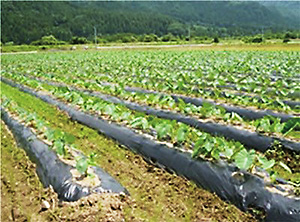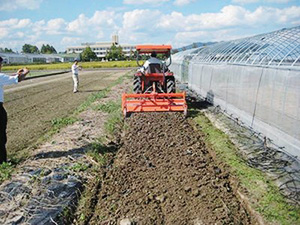Research Results
Producing plastic with microorganisms!
Closing in on the commercialization of multipurpose biodegradable plasticFY2018
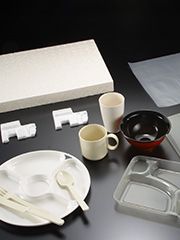
- Kaneka Corporation/Yoshiharu Doi (President, Japan Synchrotron Radiation Research Institute (JASRI))
- Development of Creative Technology Seeds, Contract Development (now NexTEP-A Type and NexTEP General Type)
- "Plant-derived biodegradable resin" development and implementing company/Representative Researcher (2008-2013)
Plastic pollution of the seas is becoming increasingly serious
While plastic is, thanks to its light weight, strength, and exceptional workability, an outstanding material that is essential in our daily lives, a number of issues have also been pointed out including the fact that plastic production consumes vast volumes of oil resources and that discarded plastic persists for long periods of time in the natural environment. It is said that the annual production output of plastic is 200 million tons and of this, 1 million tons ends up in the sea making it a source of marine pollution. Dr. oshiharu Doi president of the Japan Synchrotron Radiation Research Institute , the representative researcher of a development project "plant-derived biodegradable resin" of "Development of Creative Technology Seeds, Contract Development", began working on research into biodegradable plastic after finding out that there are microorganisms that are able to produce polyester.
Polylactic acid derived from the starch of corn, sugarcane, etc. is a type of biodegradable plastic that is already well known. Since polylactic acid is relatively hard and vulnerable to heat, however, its scope of applicability is somewhat limited. The research objective of Dr. Doi and his team is to develop biodegradable plastic that can serve as an alternative to polylactic acid.
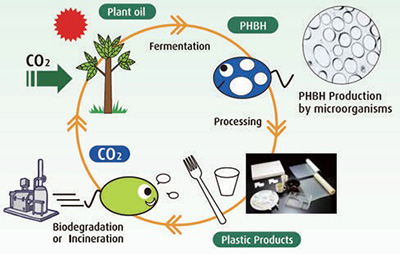
Comparison of the life c cles of biodegradable plastics and con entional plastics
Creating microorganisms able to produce biodegradable plastic in higher volumes
In 1987 Dr. Doi and his team discovered microorganisms capable of producing in their bodies a wide range of plastics from hard plastics to soft rubbery plastics. This discovery caught the attention of the industrial sector and the team engaged in collaborative research with a number of companies. In 1992, Kaneka Corporation, one of the companies with which the team was engaging in collaborative research, discovered on the site of their vegetable oil factory, microorganisms that showed even more promise. However these wild microorganisms were only able to hold approximately 30% of their body weight, making cost an issue standing in the way of commercialization. Kaneka Corporation and Dr. Doi worked on improving these microorganisms through genetic engineering and in 2006 they were successful in increasing the amount of plastic they could store up to 90% of their body weight. In order to commercialize these research findings, Kaneka Corporation was selected by JST as a contract development company in 2009 and the company subsequently commenced trial biodegradable plastic production experiments.
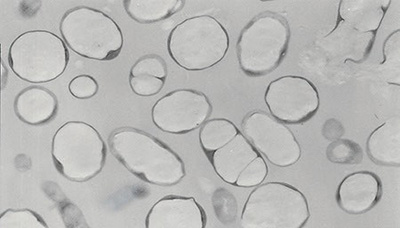
Microscope photograph of the improved microorganisms. The white parts are the biodegradable plastic, which account for the majority of the microorganisms' size.
Successful production of 1,000 tons of biodegradable plastic in one year
To cultivate these microorganisms on a commercial scale, Kaneka Corporation created a trial production plant with a capacity 100,000 times that of the laboratory scale.
While maintaining the uniformity of conditions such as temperature and humidity wasn' t a major concern when carrying out small-scale production in the laboratory, the use of larger containment vessels obviously meant that this became more of an issue. The company carried out repeated trials to identify optimal approaches to ventilation, stirring, raw material introduction, and so on, and were successful in establishing a commercially feasible level of cultivation efficiency. When sufficient plastic has accumulated within the bodies of the cultivated microorganisms they are immobilized through heat processing and the refining process begins. Plastic takes up the majority of space within the bodies of the microorganisms, which are covered in a thin shell consisting of protein and fat. Since the microorganisms are extremely small it is not possible to physically remove these shells. An eco-friendly solvent is therefore used to dissolve the shells and repeated trials were carried out to establish an appropriate amount of solvent. In this way, the company developed the purification methods and continuous production processes required to obtain plastic and in 2014, despite only using trial facilities, they managed to establish a production system capable of producing approximately 1,000 tons of plastic per year.
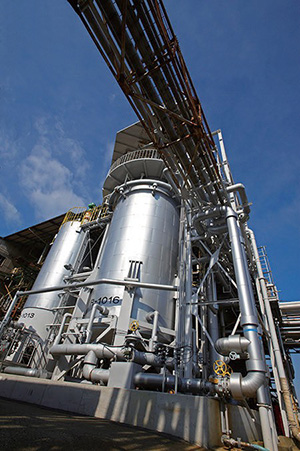
The trial production plant built on the site of Kaneka Corporation's Takasago Plant
Closing in on commercial production of films for agricultural use and other products
The biodegradable plastic produced through this research has been confirmed to have outstanding biodegradation properties both in anaerobic conditions such as when buried in soil or immersed in seawater and in aerobic conditions such as on dry land as well as when subsumed in compost, and has been registered on the Japan BioPlastics Association's green plastics "positive list" (PLA4200). The plastic's workability also allows it to be used in a range of different applications and it has been used to develop a wide variety of products including erasers, bottles, trays, and bags for compostable food waste. One of the most notable products it has been used to create is agricultural mulch film used to cover raised berms on fields. Since the plastic is soft it is possible to lay the film on the ground by unrolling it behind a tractor. Plowing the film into the ground after harvests is also a simple process, and the film breaks down in three to six months depending on the conditions in the soil affecting degradation such as the kinds of microorganisms that are present. It has also been confirmed that the plastic ultimately breaks down into carbon dioxide and water leaving no other substances behind.
With the current trend in Europe toward curbing the use of oil-derived plastics, interest in biodegradable plastics is increasing rapidly and there is considerable great expectations that its use will spread globally.
Agricultural mulch film. Spread over raised furrows using a tractor left . After harvests, the film can be plowed into the ground with a tractor.

